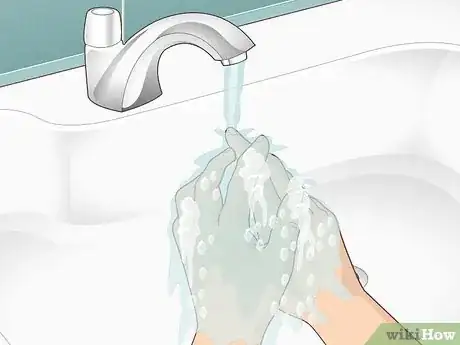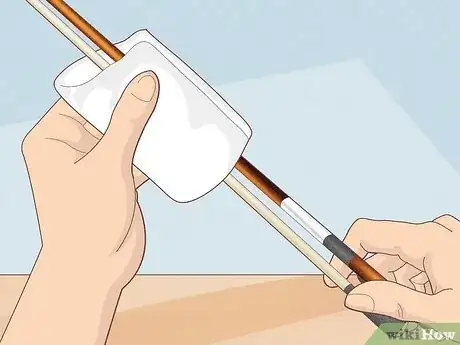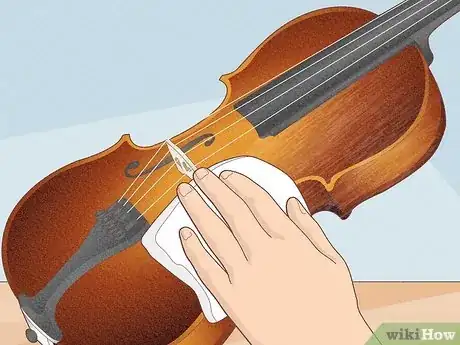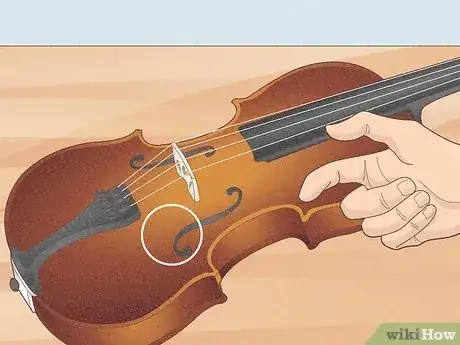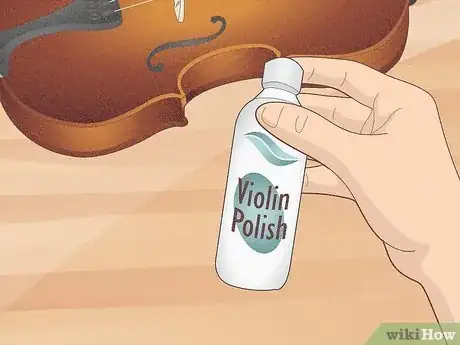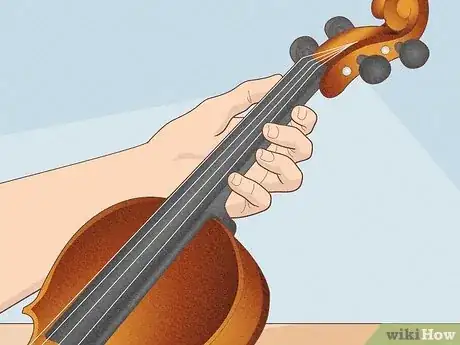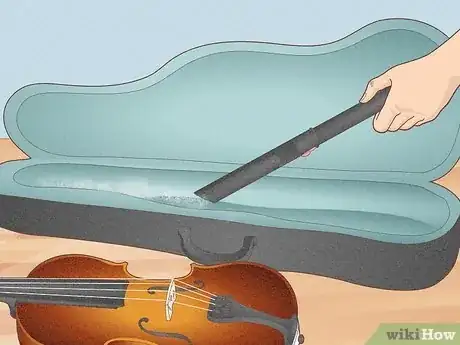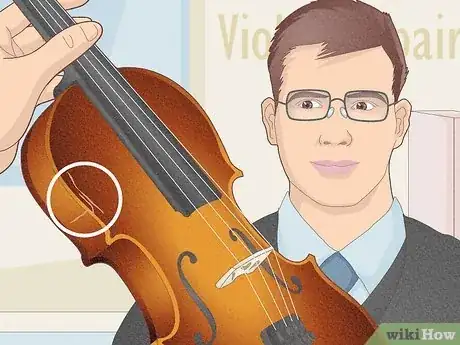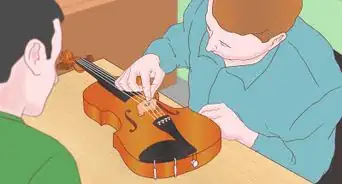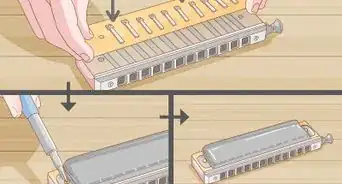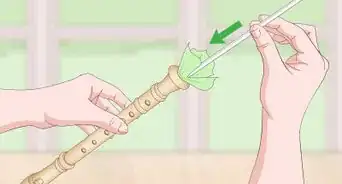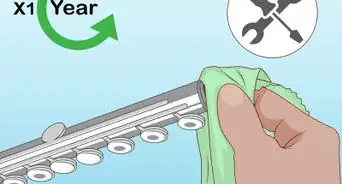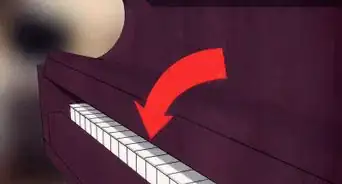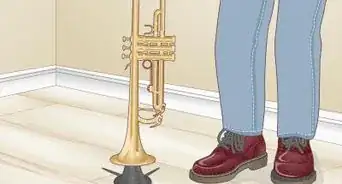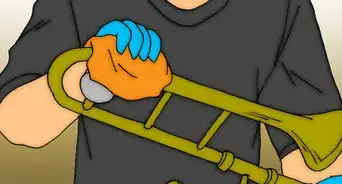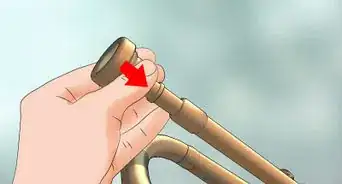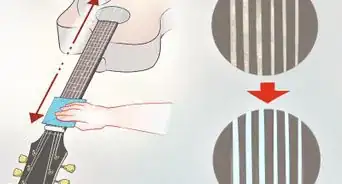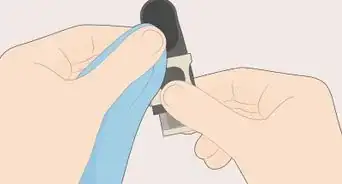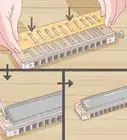This article was co-authored by Dalia Miguel. Dalia Miguel is a violinist and violin instructor based in the San Francisco Bay Area. She is studying Music Education and Violin Performance at San Jose State University and has been playing violin for over 15 years. Dalia teaches students of all ages and performs with a variety of symphonies and orchestras in the Bay Area.
There are 7 references cited in this article, which can be found at the bottom of the page.
wikiHow marks an article as reader-approved once it receives enough positive feedback. In this case, 90% of readers who voted found the article helpful, earning it our reader-approved status.
This article has been viewed 112,849 times.
So, you've got your violin, and you already know how to take care of it. But what about the day-to-day cleaning routine? How can you keep your violin from getting "gunked up" with rosin, sweat, and body oils?[1] This wikiHow will lay out the steps to take before putting your violin in its case. It is up to you to develop the habits that will ensure your violin will last long into the future, and beautifully so.
Steps
Wiping Your Violin Down
-
1Wash your hands. After your practice session, you will likely have some rosin, sweat, and grime on your hands which you don’t want to accidentally transfer onto different parts of your violin.
-
2Get several cleaning cloths. Cleaning cloths help prevent buildup of rosin and other substances and also keep your violin looking nice by removing fingerprints and other markings. You always want to have at least two soft, clean, lint-free cloths to wipe down the various parts of your violin.
- Be sure to keep these cleaning cloths in your violin case so that they’re on hand at all times.
- You can buy cleaning cloths that are specially made for violin cleaning, such as SHAR or Glaesel, but you can also use what you have, such as flannel. Just be sure you are using a cloth that is soft and non-abrasive.
Advertisement -
3Wipe down the strings. It is important to wipe down the strings of your violin after each playing session because rosin can quickly accumulate and change the sound of your instrument. This is an easy step that should become a regular habit after practicing.
- Using one cloth, wipe the rosin off each individual string, moving up and down each string in a sliding motion. Be sure to wipe off any rosin flakes that might break off during this step.
- If there is a build-up of rosin on your strings that you cannot wipe off, you can use pure alcohol to remove this. Put a few drops of alcohol on the cloth and rub on the strings, but be careful to ensure that the alcohol does not touch any other part of the violin as alcohol will damage the varnish.[2]
-
4Wipe the bow. Just like on the strings, rosin can build up relatively quickly on the bow. You can use the same cloth you used for the strings as you are wiping away the same substance.
- Just as with the strings, simply take the cleaning cloth to wipe down the bow in the direction that the hairs are running in. Do not go against the grain, just wipe up and down using a light touch.
- You might consider taking out the screw first before wiping the bow. That way, your cloth will not be touching the hair and wiping the rosin off that.
-
5Wipe down the face of the violin. The face of the violin refers to its body, excluding the strings or neck of the violin. You will want to use a different cloth for this step, as you want to avoid rubbing rosin or any other substance onto the violin.
- When wiping the F-holes, take care to ensure the cloth does not get caught in them. The woodwork of F-holes is delicate and can change or ruin the sound of the violin if damaged.[3]
-
6Clean the bridge. The bridge of the violin is liable to have collected some rosin during your practice session. Use a cloth to dust the rosin out from under the bridge but maintain a light touch, as the bridge is very fragile.
- Try using a Q-tip for those spots that are especially hard to reach.
Polishing Your Violin
-
1Know when to polish your violin. Having a polished violin keeps the varnish in good shape and also takes care of the gunky build up that inevitably occurs after years of playing any instrument.
- If your violin is new or in good shape, you may not need to polish it at all. However, if your instrument is dull and hasn’t been polished in a long time (a year or more), you may want to polish it. Check with your luthier (a specialist in string instruments) if you aren’t sure.
-
2Get the right type of polish. Only use a commercial violin polish rather than furniture polish or water as these can damage both the varnish and sound of the violin.[4]
- Never use violin cleaners or polishes on master instruments or antiques, because the oils they contain could open a crack and make your instrument difficult to restore.[5]
- Polishes generally contain some type of oil, which can create fissures in the violin’s wood and damage the instrument in the long run. Therefore, there is some disagreement over whether polishes should be used on violins at all.[6]
-
3Use a cloth to polish. If you do decide to use polish on your violin, be sure to follow the specific instructions that come with your polish and be careful to only polish the body of the violin.
- Apply polish to the cloth, not directly on the instrument. Rub out the smudges, dirt, any rosin buildup, using the cloth. Buff on all sides, but be careful around the F-holes to prevent polish buildup. Then take a separate rag to wipe off any excess polish to prevent moisture from entering in and damaging the violin.
- Avoid the strings and bridge of the violin as you don’t want any polish building up on these parts and affecting the sound of the instrument.
Maintaining Long Term Cleanliness
-
1Limit the places you touch with your hands. The oils and sweat on your skin can attack the varnish of your violin and leave marks. The less skin contact you make with your violin, the longer it will last in terms of great sound and appearance.
- Practice lifting and holding your violin as little as possible until it becomes second nature to not grab and touch your violin all over its body.
-
2Clean your case. Though people often forget about this step, your violin will not stay clean if its storage case is not clean. Empty and vacuum out your case once a week or once you start seeing flakes of dust, dirt, and rosin.
- This step has the added benefit of preventing dust mites that may eat your violin’s bow hair.[7]
-
3Know when it’s time for a professional tune-up. If you start to notice cracks or other changes in your violin, it’s time to take your instrument into a reputable violin maker or music store.[8]
Community Q&A
-
QuestionWhat kind of cloth can I use?
 Community AnswerSoft linen is great for cleaning a violin as it doesn't scratch or leave lint behind. Soft cotton will also work.
Community AnswerSoft linen is great for cleaning a violin as it doesn't scratch or leave lint behind. Soft cotton will also work. -
QuestionWhy can't we use water to clean our violin?
 Community AnswerBecause the water could ruin the finish or even warp the wood.
Community AnswerBecause the water could ruin the finish or even warp the wood. -
QuestionCan a microfiber cloth be used in place of the flannel cloth?
 Community AnswerYes. Many violin cleaning cloths are microfiber. This will work just fine.
Community AnswerYes. Many violin cleaning cloths are microfiber. This will work just fine.
References
- ↑ Dalia Miguel. Experienced Violin Instructor. Expert Interview. 27 August 2018.
- ↑ http://www.corilon.com/shop/en/info/violin-tips.html#2
- ↑ http://violin.yourmusicsupply.com/parts-of-the-violin/
- ↑ http://www.violinonline.com/instrumentcare.htm
- ↑ http://theviolinstudio.com/violinmaintenancecelloviolaviolinmaintenancedaily/
- ↑ http://www.violinist.com/discussion/response.cfm?id=13148
- ↑ http://theviolinstudio.com/violinmaintenancecelloviolaviolinmaintenancedaily/
- ↑ Dalia Miguel. Experienced Violin Instructor. Expert Interview. 27 August 2018.
- ↑ Dalia Miguel. Experienced Violin Instructor. Expert Interview. 27 August 2018.
About This Article
To clean a violin, start by wiping the rosin off of each string using a clean cloth. If there's rosin build-up that you can't get off, apply a few drops of alcohol to the cloth before you wipe down the strings. Next, take the same cloth and gently wipe off the bow, wiping in the direction that the hairs go in. Then, take a new clean cloth and wipe down the face of your violin to remove any smudges or fingerprints. Finally, use a cloth and cotton swab to gently clean off any dust in the bridge. To learn how to polish a violin, scroll down!

